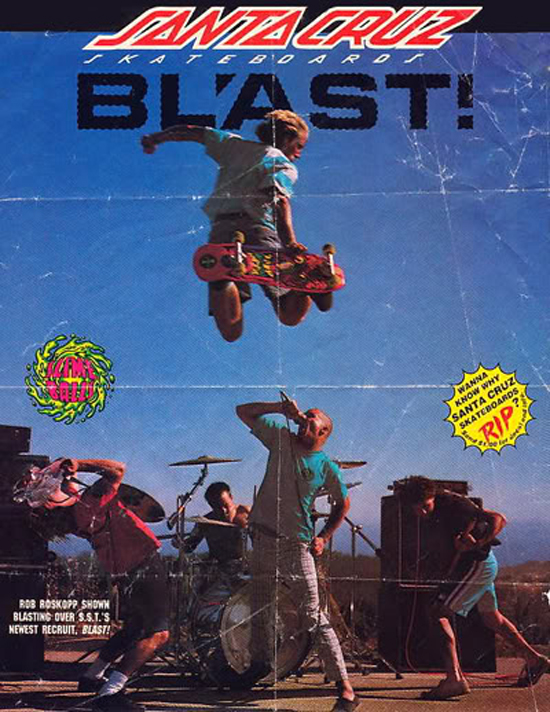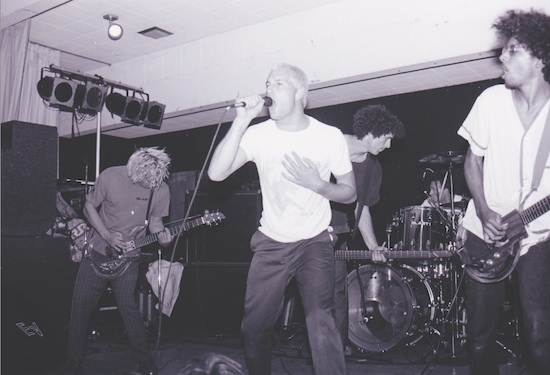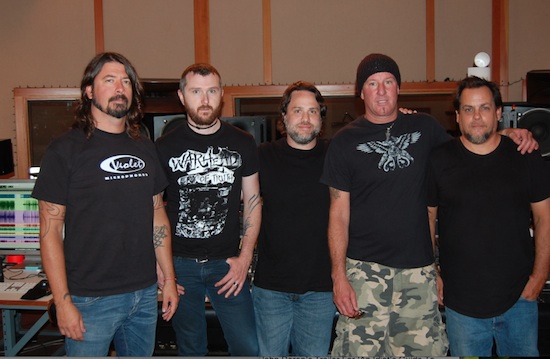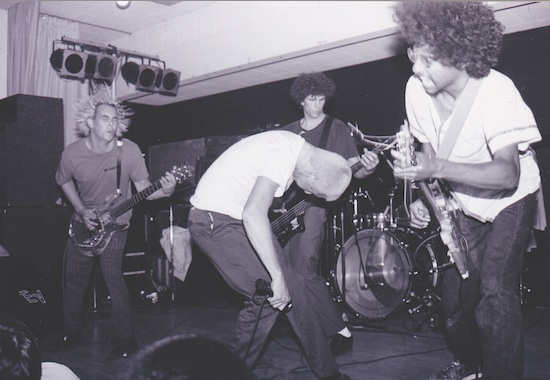"I wasn’t really familiar with them. I was at CBGBs in 1986. I remember watching them set up their equipment, plug in and hit the first chord as I was sitting on the stage, and it fucking BLEW my MIND! They were one of the loudest, heaviest bands I’d ever seen in life. It was just noise and feedback – it was insane." Foo Fighters frontman Dave Grohl is recalling his first exposure to Bl’ast, the cult California hardcore band for whom he has just remixed a long-lost, quarter-of-a-century old recording session that captures the band at the absolute peak of their powers. That kind of epiphany is one that cements a lifelong devotion, an obsession that Grohl is far from alone in possessing.
Formed in the northern Californian seaside town of Santa Cruz, Bl’ast were never an easy sell in the often overly orthodox world of 80s hardcore punk. Taking their cues from Black Flag’s angular, angsty later period, blending it with the east-coast aggression of Minor Threat and SS Decontrol then adding a huge dollop of Black Sabbath on top, they were often regarded as outsiders in their own scene. As Grohl puts it: "They were considered a hardcore band, but they were a lot more than that. They were waaay heavier than all the other bands."
By 1983, singer Clifford Dinsmore had already served time in M.A.D, an embryonic version of Bl’ast that achieved a certain amount of notoriety thanks to their appearance on the Alternative Tentacles compilation LP Not So Quiet On The Western Front. However, faced with the small-town adolescent conundrum of what to do with the rest of his life, Dinsmore had, by his own admission, "faded out of the band for a while". But it was the addition of guitarist Mike Neider, and a lo-fi recording of the band now rebranded as Bl’ast, that convinced Dinsmore to put his life plans on hold. "Somehow I got a tape of their songs," he recalls. "It was just a ghetto blaster recording, but it sounded incredible, and it was all the songs that would be [Bl’asts 1986 debut] The Power Of Expression. I listened to it and thought, ‘What in the hell is this?’
"It was a pretty confusing point in my life. I didn’t know the hell I was going to do, whether I was going to school or move away or whatever. Then I heard that stuff and I thought, ‘Man, I don’t really know what’s going on here, but I gotta stick around and do this, because this is awesome.’" He pauses, then laughs. "And I’ll probably really regret it later."
Straight away, Bl’ast set themselves up in opposition to their peers. While the rut that would derail the first wave of hardcore punk was still a couple of years away, the movement’s dogmatic philosophy was very much alive: experimentation was viewed with suspicion, and introducing rock and metal elements to your music could be career suicide. Dinsmore recalls: "There were people who got into punk just to be punk, for the fashion, and just to play songs that were really generic, with the same drum beat over and over, and that really bugged us. We didn’t like that about punk. Punk was about breaking away from conformity, so why does every band have to look and sound the same?"
Despite this, Bl’ast were very much products of their environment, and for Grohl they remain "the quintessential California hardcore band". "When you look at them, you just saw an empty swimming pool with Alva skateboards ripping through it, or a Germs or Black Flag show where there’s riots and cops beating the shit out of people," he says. "There was just something about them that you thought, ‘Those fucking guys are for real!’ You know they live a block from the beach; you know they skate up and down the boardwalk every day; and you know that they would kick your ass if you got in their way. They were bad ass!"
Feature continues below image

With The Power Of Expression released in 1986 on Wishing Well Records, home of fellow Cali hardcore stars Uniform Choice, and a burgeoning reputation for incendiary, intense live shows, it wasn’t long before they appeared on the radar of their heroes, Black Flag. Bass player Chuck Dukowski lobbied for them to be signed to SST, and guitarist and label owner Greg Ginn agreed. SST reissued their debut, and released two more albums, It’s In My Blood, and Take The Manic Ride. Bl’ast’s confrontational,challenging brand of hardcore had received its ultimate vindication. "I used to hang out with Black Flag a lot back in those early days when I was 16 or 17," says Dinsmore. "They were such a different band for the time period, and the bands that were really doing something different were the bands that we looked up to. That’s what we set out to do, to make really heavy, really different music."
Unfortunately, such close proximity to their prime influence made it easy for people to dismiss them as slavish copyists. It’s an unfair argument that doesn’t take into account the nuances that Bl’ast brought to the table, and a dynamicism that saw them embellish upon and, some would argue, supersede the Black Flag sound.
Grohl takes up the fight. "The way I looked at Bl’ast is that it was an amplified version of the Black Flag ethic," he emphasises. "At the same time, Black Flag seemed kind of claustrophobic in a beautiful way. It was a fucking dark place, the world where Greg and Henry [Rollins] were. But Bl’ast’s world had more of a mystery to it, and was almost playful in a way. And if you read Clifford’s lyrics, there’s a real vulnerability there from the start, which Henry maybe kind of got to later on."
Sunn O)))’s Greg Anderson, a lifelong Bl’ast fan whose Southern Lord label released the Grohl-mixed recordings this month, is even more emphatic: "I get a lot of shit for this, but I actually prefer Bl’ast over Black Flag. I think they’re better. Obviously, it’s a chicken and egg thing; there would be no Bl’ast without Black Flag. By the time I’d got into Flag, they’d grown out their hair, and they were listening to the Grateful Dead … and they were older than me. They’d moved on. But when I heard Bl’ast, it was like, ‘Well, they’ve got that cool Black Flag thing going on, but done with this super hardcore intensity – and these are guys that I can relate to.’ I was 15, and that whole sexual element to Black Flag? Ah, that wasn’t something I was into. Black Flag will always be one of my favourite bands – but Bl’ast spoke to me more."
Dinsmore admits that the comparisons rankled with the band, too: "I think it pushed us to go farther and farther away from convention. The It’s In My Blood era was the perfect era of us really breaking convention and doing something different. By the time Manic Ride came out [in 1989], it was just so far gone that it was over a lot of people’s heads. Like we kinda just strayed too far." Dinsmore left the band the following year, and Bl’ast called it a day in December 1990.
Fast forward to the present day, and Bl’ast have been given a new lease of life by very unexpected circumstances: the discovery of a long-forgotten, scrapped recording session found at the bottom of a pile of junk. "It was found in our drummer’s storage unit," says Dinsmore. "I don’t think he was even aware he had them. We lost a lot of stuff along the way, so these were the only remaining master tapes of any of our recordings. But they had basically become the property of the storage company. We were anticipating that it was going to be auctioned off for two bucks like in Storage Wars or something. We were afraid of them holding it ransom, but somehow we negotiated, paid a couple of bills, and we got our hands on them."
Dinsmore then contacted Anderson – Southern Lord had previously released an album by Dinsmore’s post-Bl’ast project Spaceboy – to see if he was interested in doing something, anything, with these mysterious Bl’ast recordings. Anderson, unsurprisingly, jumped at the chance. But of course, this being Bl’ast, nothing is ever that simple. "The tapes almost didn’t make it," says Dinsmore. "It would have been 26 years to the day since they were recorded when they put them on the machine … and the tapes immediately started to flake off."
Anderson continues: "We sent them up to our guy in Portland. He had to find a machine that could play them. And when he put it on, it actually shut down the machine because they basically started turning into a pile of ash. So he stopped the machine immediately and took them off and sent him to a guy that he knew that could save the tapes, which actually involved putting them into an oven and baking them. If it’s successful, it can actually preserve the information that’s on those tapes for maybe one or two plays before they are unusable again. Often, it just won’t take. But it worked!"
Once it was clear the tapes had been saved, and the audio from the multi-track recordings could be preserved digitally, Anderson had only one thought for who he would get to mix them – friend, fellow Seattle scene veteran and Bl’ast devotee Dave Grohl. Anderson recalls: "I immediately called Dave. I’d just seen his Sound City documentary, so I called him up and said, ‘Dude, you’re never going to believe this. But I’ve got these Bl’ast master tapes. Would you be into checking them out at your studio? And he was like, ‘Fuck yeah!’

"But we really didn’t know what we had – there was no information that came on the tapes. No track sheets or the usual stuff. So he said, ‘Why don’t we just have a listen and see what we have?’
What they had was not only a complete recording session of Bl’ast from 1987, during the It’s In My Blood era, but a rare document of the short period of time when a young guitarist from the Georgia hardcore band Neon Christ had joined on second guitar. His name was William ‘Kip’ Duvall, and while his spell in Bl’ast was fairly brief – a few months at most – he has since forged out a reasonably successful career as the frontman of Alice in Chains. But I digress. Back to the studio.
Says Grohl: "We put the tracks up on my board – the old Sound City one that everyone from Johnny Cash to Neil Young to Metallica … everyone’s made a record on this board! We put the tracks on the board and it just sounded So. Fucking. Good! It was like you were in the room with them. I used that night at CBGBs as my reference. I was six feet from their amps and they were right in my face. That’s the way to experience a band. Listening to records is great, but being so close to a band that your teeth itch because it’s so loud – that’s how I like to experience it. We were just listening to those recordings and try to amplify the reality of them.
"Back in those days when you recorded a band, you put them in a room and you hit record," he continues. "And that’s why the good bands are great and the shitty bands are shitty. You were what you were, and those recordings – that was Bl’ast, man. In a fucking room! To isolate those tracks, it was like doing an autopsy. You’re just picking through each little track, going, ‘Fuck, listen to that! You can hear him breathing! You can hear him turning the pages on a lyric sheet.’ I get off on that kind of shit – I’m a nerd."
It’s one of the unfortunate ironies of underground music that the true pioneers rarely get the recordings they deserve, as they are frequently at the mercy of producers and engineers who don’t have a clue what the band are trying to achieve. Never has this been more true than for many of the original hardcore bands, where astounding groups have been neutered by flat recordings and tamed performances. For Grohl and Anderson, this wasn’t just a case of unearthing a lost rarity. This was a chance to go back and right the wrongs suffered by so many young bands dealing with an industry totally ignorant of their ambitions.
"Back in the those days it was really difficult to find a place to record because no one understood the music we were making," recalls Anderson. "I remember when Brotherhood [Anderson’s straight-edge hardcore band, which also featured Foo Fighters bassist Nate Mendel] were recording our record. It was just some dude, some burned out rocker guy whose point of references were Foghat and Nugent – ‘Alriiight! Loud guitars!’, you know – but he didn’t understand punk, he didn’t understand hardcore. There weren’t the cool guys that there are now – the Kurt Ballous or the Billy Andersons – the guys that really have their head in the music, and understand it inside out. It wasn’t like that back then – getting a good recording was just super-rare."
For Grohl, the only way to tackle this issue was take the whole thing back to basics. "There was a funny thing that happened in the 80s where people were using all these weird digital effects to create space or delay or reverb rather than finding the simple power of recording an instrument. So we stripped it of all the 80s-ness. And just fucking cranked it – and it sounds like Bl’ast!"
Anderson concurs: "’Let’s try and make it sound as powerful and intense as when we saw them play
live.’ That was the goal."

Inevitably, as word spread that work was taking place to resurrect a lost artefact of one of the more important – if occasionally undervalued – trailblazers of the heavier end of the musical spectrum, scene luminaries began turning up to pay tribute. Anderson says: "We had a whole crew of people that came down – Scott Hill from Fu Manchu, he was losing his mind – Bl’ast are one of his favourite bands of all time, Nick Oliveri [Queens of the Stone Age and Mondo Generator] came down. So we just had a crew of nerds from the old school just hanging out, and of course Clifford and Mike from Bl’ast – it was a lot of fun. Everyone had really good suggestions, because they’ve listened to these songs for so long. It was like a Bl’ast think tank, going back in time to make improvements.
"Listening to these individual tracks of songs that have been burned in my brain for 25 years and hear just the guitar or just Clifford’s voice, it was pretty fucking amazing! It was seriously like being in a dream. ‘I’m listening to the original tracks of my favourite band ever!’ … and then you wake up. But that really was the case – we were there listening to this stuff, losing our minds. We referred to it as ‘The Time Machine’. ‘All right! Get in and set the dials to 1986!’"
The end result is phenomenal – it sounds as immediate and fresh as if it was recorded last week, and with Bl’ast at the height of their pioneering powers, there is no danger of these songs sounding dated, even for those familiar with the ‘originals’ from It’s In My Blood. "It’s the fucking triple crown," says Anderson. "Not only is the recording really good, the performances are great, and the songwriting is really interesting and ahead of its time. It really isn’t your formulaic 1-2-3-4 hardcore music."
The whole process had an emboldening effect on Dinsmore, too, with a reunion with Neider firmly on the cards – with a little help from some high-profile fans. "Mondo Generator were playing at the bar where I work in Santa Cruz," says Dinsmore. "I was talking to Nick about Bl’ast. I said, ‘Well, it’s weird that you mention it, but there’s a possibility of some live shows.’ He asked me who was playing bass. ‘Fuck, dude, you should do it!’ I said. He was like. ‘Are you serious? Here’s my number.’ Then he played that night, and completely kicked ass, and I’m looking at Hoss the drummer, just killing it, too. And I thought, ‘Wow, this could work.’ It sucks when bands can’t have all their original members, but with a couple of heavy hitters like that, it’s not going to make too much of a difference."
Like the luxury of being able to go back and remix a recording from a quarter of century ago, reuniting the band has given Dinsmore the chance to address a huge missed opportunity from his youth – namely a European tour that never happened. "We had a whole month booked, between Power Of Expression and It’s In My Blood," says Dinsmore. "A couple of the guys in the band didn’t take it too seriously. But I was saying, ‘This stuff is booked. It’s happening. Is everyone ready? Do you have your passports?’ Then they got cold feet, and that was the basis of an early break-up. We didn’t break up officially, but we didn’t speak for a month or two.
"Given the momentum we had at that time, it would have been an awesome experience. It’s just blew my mind that people didn’t just think, ‘Fuck yeah, Let’s go!’ It was such a bummer."
He pauses, the darkness in his voice subsiding. "That’s just why it feels like we’re way overdue to get out again … and get over there. Things are starting to fire up again!"
Bl’ast’s Blood is out now on Southern Lord Records


